Mechanical Properties of Cement-Treated Soil Mixed with Cellulose Nanofibre
Abstract
:1. Introduction
2. Materials and the Mixture Method
2.1. Characteristics of CNF Used
2.2. Characteristics of Soil and Cement
2.3. Mixture Procedure of Soil, Cement, and CNF
2.3.1. Method 1
2.3.2. Method 2
3. Effect of CNF on Strength Increase
3.1. Unconfined Compressive Strength
3.2. Flexural Strength
4. Effect of CNF on Strength Variability
4.1. Dispersion of Unconfined Compressive Strength
4.2. Evaluation of Variability
5. Effect of CNF on Permeability
5.1. Test Method
5.2. Test Results
6. Conclusions
- The method of mixing either the soil or the additive (cement, CNF) in a dry state was attempted to reduce the amount of water in the treated soil. Both methods could be used, but for on-site mixing, it was considered more practical to mix cement and CNF in dry powder or highly concentrated gel form.
- During the mixing of cement and soil, the water absorption and thickening properties of the CNF reduced the flowability, but as a result, it was possible to mix the cement evenly, which was probably because of the other effects at work. In addition, when the mixing time was extremely short, unevenness was observed between the solidified portions and those that did not solidify in the specimen without CNF, whereas the treated soil was produced uniformly in the specimen with CNF.
- In regard to the strength development characteristics over time, it was found that the mixture of CNF increased the strength at the initial age, but it reduced the strength development in the long term. Increasing the initial strength and reducing the long-term strength can be advantageous for cement treatment. Observation of the sheared surface showed that a fibrous material, which was considered to be CNF, was widely mixed in the specimens to which CNF with a relatively low degree of friability was added.
- The effect of shortening the mixing time on the variation in the strength of CNF was investigated. It was observed that the cement tended to mix more evenly in the treated soil with CNF, and the average strength ratio at 28 days of age was 5.1 (strength with CNF/strength without CNF). The coefficients of variation of the strength and failure strain were also smaller when CNF was added. Reducing the variation in the strength of the treated soil has the advantage that the amount of cement added can be reduced, and unwanted high-strength treated soil is not produced.
- The addition of CNFs increased the flexural strength. This could be attributed to the increased tensile strength. Fibrous material appeared on the tensile fracture surface of the specimen to which CNF with low fibrillation was added. The low flexural and tensile strength is one of the drawbacks of cement-treated soil, and this problem could be solved.
- The addition of CNF caused a slight change in permeability, although the number of tests in this study was not sufficient to determine a clear effect. It would suggest that the addition of CNF does not significantly change the permeability. The pore water conditions were estimated from the effluent, and it was found that the alkaline atmosphere was the same regardless of the presence or absence of CNF.
7. Patents
Author Contributions
Funding
Institutional Review Board Statement
Informed Consent Statement
Acknowledgments
Conflicts of Interest
References
- Saito, T.; Nishiyama, Y.; Putaux, J.L.; Vignon, M.; Isogai, A. Homogeneous suspensions of individualized microfibrils from TEMPO-catalyzed oxidation of native cellulose. Biomacromolecules 2006, 7, 1687–1691. [Google Scholar] [CrossRef]
- Abe, K.; Iwamoto, S.; Yano, H. Obtaining cellulose nanofibers with a uniform width of 15 nm from wood. Biomacromolecules 2007, 8, 3276–3278. [Google Scholar] [CrossRef]
- Iwamoto, S.; Abe, K.; Yano, H. The effect of hemicelluloses on wood pulp nanofibrillation and nanofiber network characteristics. Biomacromolecules 2008, 9, 1022–1026. [Google Scholar] [CrossRef]
- Jiao, L.; Su, M.; Chen, L.; Wang, Y.; Zhu, H.; Dai, H. Natural cellulose nanofibers as sustainable enhancers in construction cement. PLoS ONE 2016, 11, e0168422. [Google Scholar] [CrossRef] [PubMed] [Green Version]
- Fu, T.; Moon, R.J.; Zavattieri, P.; Youngblood, J.; Weiss, W.J. Cellulose nanomaterials as additives for cementitious materials. Cellul. Reinf. Nanofibre Compos. 2017, 455–482. [Google Scholar] [CrossRef]
- Mejdoub, R.; Hammi, H.; Suñol, J.J.; Khitouni, M.; M’nif, A.; Boufi, S. Nanofibrillated cellulose as nanoreinforcement in Portland cement: Thermal, mechanical and microstructural properties. J. Compos. Mater. 2017, 51, 2491–2503. [Google Scholar] [CrossRef]
- Kitazume, M.; Terashi, M. The Deep Mixing Method; CRC Press/Balkema: London, UK, 2013; pp. 1–436. [Google Scholar] [CrossRef]
- Consoli, N.C.; Prietto, P.D.M.; Ulbrich, L.A. Influence of fiber and cement addition on behavior of sandy soil. J. Geotech. Geoenvironmental Eng. 1998, 124, 1211–1214. [Google Scholar] [CrossRef]
- Consoli, N.C.; Montardo, J.P.; Donato, M.; Prietto, P.D.M. Effect of material properties on the behaviour of sand-cement-fibre composites. Ground Improv. 2004, 8, 77–90. [Google Scholar] [CrossRef]
- Consoli, N.C.; de Moraes, R.R.; Festugato, L. Split tensile strength of monofilament polypropylene fiber-reinforced cemented sandy soils. Geosynth. Int. 2011, 18, 57–62. [Google Scholar] [CrossRef]
- Estabraph, A.R.; Namdar, P.; Javadi, A.A. Behavior of cement-stabilized clay reinforced with nylon fiber. Geosynth. Int. 2012, 19, 85–92. [Google Scholar] [CrossRef]
- Correia, A.A.S.; Oliveira, P.J.V.; Custodio, D.G. Effect of polypropylene fibres on the compressive and tensile strength of a soft soil, artificially stabilised with binders. Geotext. Geomembr. 2015, 43, 97–106. [Google Scholar] [CrossRef] [Green Version]
- Correia, A.A.S.; Oliveira, P.J.V.; Teles, J.M.N.P.C.; Pedro, A.M.G. Strength of a stabilised soil reinforced with steel fibres. Geotech. Eng. 2017, 170, 312–321. [Google Scholar] [CrossRef]
- Tang, Q.; Shi, P.; Zhang, Y.; Liu, W.; Chen, L. Strength and deformation properties of fiber and cement reinforced heavy metal-contaminated synthetic soils. Adv. Mater. Sci. Eng. 2019, 1–9. [Google Scholar] [CrossRef] [Green Version]
- Wang, W.; Zhang, C.; Guo, J.; Li, N.; Li, Y.; Zhou, H.; Liu, Y. Investigation on the triaxial mechanical characteristics of cement-treated subgrade soil admixed with polypropylene fiber. Appl. Sci. 2019, 9, 4557. [Google Scholar] [CrossRef] [Green Version]
- Correia, A.A.S.; Casaleiro, P.D.F.; Rasteiro, M.G.B.V. Applying multiwall carbon nanotubes for soil stabilization. Procedia Eng. 2015, 102, 1766–1775. [Google Scholar] [CrossRef] [Green Version]
- Correia, A.A.S.; Rasteiro, M.G. Nanotechnology applied to chemical soil stabilization. Procedia Eng. 2016, 143, 1252–1259. [Google Scholar] [CrossRef] [Green Version]
- Saito, T.; Kimura, S.; Nishiyama, Y.; Isogai, A. Cellulose nanofibers prepared by TEMPO-mediated oxidation of native cellulose. Biomacromolecules 2007, 8, 2485–2491. [Google Scholar] [CrossRef]
- Kondo, T.; Kose, R.; Naito, H.; Kasai, W. Aqueous counter collision using paired water jets as a novel means of preparing bio-nanofibers. Carbohydr. Polym. 2014, 112, 284–290. [Google Scholar] [CrossRef]
- Japanese Standards Association. JIS R 5201—Physical Testing Methods for Cement; Japanese Standards Association: Tokyo, Japan, 2019; pp. 1–107. [Google Scholar]
- Japanese Standards Association. JIS A 1216—Method for Unconfined Compression Test of Soils; Japanese Standards Association: Tokyo, Japan, 2020; pp. 1–16. (In Japanese) [Google Scholar]
- Japanese Geotechnical Society. JGS 0511—Method for unconfined compression test of soils. In Japanese Geotechnical Society—Laboratory Testing Standards of Geomaterials; Japanese Geotechnical Society: Tokyo, Japan, 2020; pp. 1–6. [Google Scholar]
- Terashi, M.; Tanaka, H.; Mitsumoto, T.; Niidome, Y.; Honma, S. Fundamental Properties of Lime and Cement Treated Soil, 2nd ed.; Port and Airport Research Institute: Kanagawa, Japan, 1980; Volume 19, pp. 33–62. (In Japanese)
- Kanda, T.; Tanaka, T.; Nohara, H.; Kubota, J. Development of high-performance fiber-reinforced soil cement. Annu. Rep. Kajima Tech. Res. Inst. 1999, 47, 79–85. (In Japanese) [Google Scholar]
- Namikawa, T.; Koseki, J. Evaluation of tensile strength of cement-treated sand based on several types of laboratory tests. Soils Found. 2007, 47, 657–674. [Google Scholar] [CrossRef] [Green Version]
- Coastal Development Institute Technology. The Premixing Method; CRC Press: London, UK, 2003; pp. 1–152. [Google Scholar] [CrossRef]
- Kitazume, M. The Pneumatic Flow Mixing Method; CRC Press/Balkema: London, UK, 2017; pp. 1–233. [Google Scholar] [CrossRef]
- Chew, S.H.; Kamruzzaman, A.H.M.; Lee, F.H. Physicochemical and Engineering behavior of cement treated clays. J. Geotech. Geoenvironmental Eng. 2004, 130, 696–706. [Google Scholar] [CrossRef]
- Takahashi, H.; Kitazume, M. Consolidation and permeability characteristics on cement treated clays from laboratory tests. In Proceedings of the International Symposium on Engineering Practice and Performance of Soft Deposits, Toyonaka, Japan, 2–4 June 2004; pp. 187–192. [Google Scholar]
- Vähäaho, I.; Kangas, H.; Takahashi, H.; Kitazume, M. Effect of permeability and stiffness of treated column on consolidation phenomenon of improved ground. In Proceedings of the 16th International Conference on Soil Mechanics and Geotechnical Engineering, Osaka, Japan, 12–16 September 2005; pp. 1269–1274. [Google Scholar]
- Terashi, M.; Tanaka, H.; Mitsumoto, T.; Honma, S.; Ohhashi, T. Fundamental Properties of Lime and Cement Treated, 3rd ed.; Port and Airport Research Institute: Kanagawa, Japan, 1983; Volume 22, pp. 69–96. (In Japanese)
- Kitazume, M.; Nakamura, T.; Terashi, M.; Ohishi, K. Laboratory tests on long-term strength of cement treated soil. In Proceedings of the 3rd International Conference on Grouting and Ground Treatment, New Orleans, LA, USA, 10–12 February 2003; Volume 1, pp. 586–597. [Google Scholar]
- Hayashi, H.; Nishikawa, J.; Ohishi, K.; Terashi, M. Field observation of long-term strength of cement treated soil. In Proceedings of the 3rd International Conference on Grouting and Ground treatment, New Orleans, LA, USA, 10–12 February 2003; Volume 1, pp. 598–609. [Google Scholar]
- Ikegami, M.; Ichiba, T.; Ohishi, K.; Terashi, M. Long-term strength change of cement treated soil at Daikoku Pier. In Proceedings of the Soft Ground Engineering in Coastal Areas, Yokusuka, Japan, 28–29 November 2002; pp. 241–246. [Google Scholar]
- Committee on Geocement. A study on long term stability of soil-cement columns improved by geocement. Cem. Concr. 2014, 804, 9–14. (In Japanese) [Google Scholar]
- Takahashi, H.; Morikawa, Y.; Fujii, N.; Kitazume, M. Thirty-seven-year investigation of quicklime-treated soil produced by deep mixing method. Ground Improv. 2018, 171, 135–147. [Google Scholar] [CrossRef] [Green Version]
- Takahashi, H.; Morikawa, Y.; Uemura, T. Trial tests to promote degradation of cement treated soil by percolation technique. In Proceedings of the Deep Mixing 2021, Online, 15–17 June 2021. [Google Scholar]



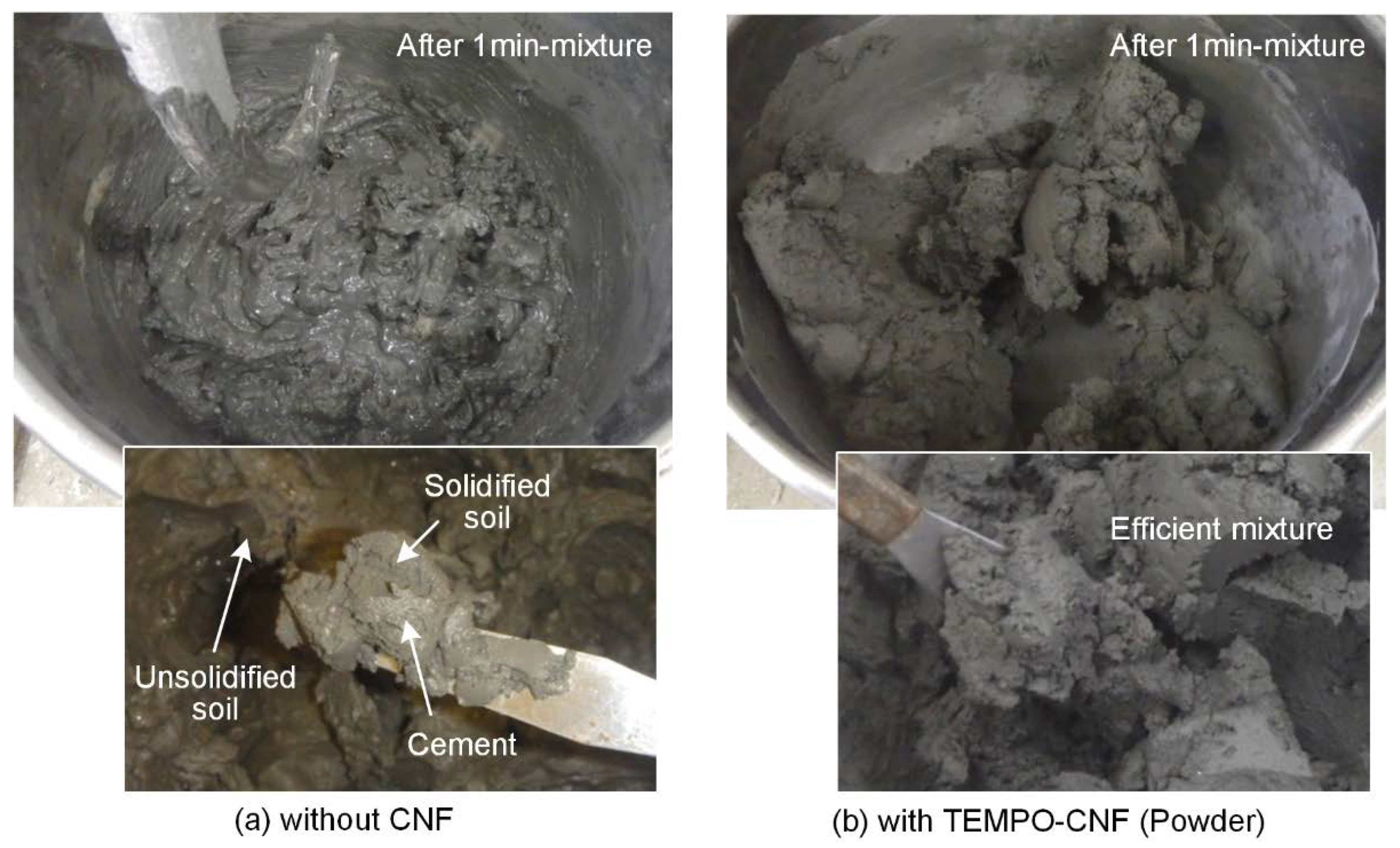

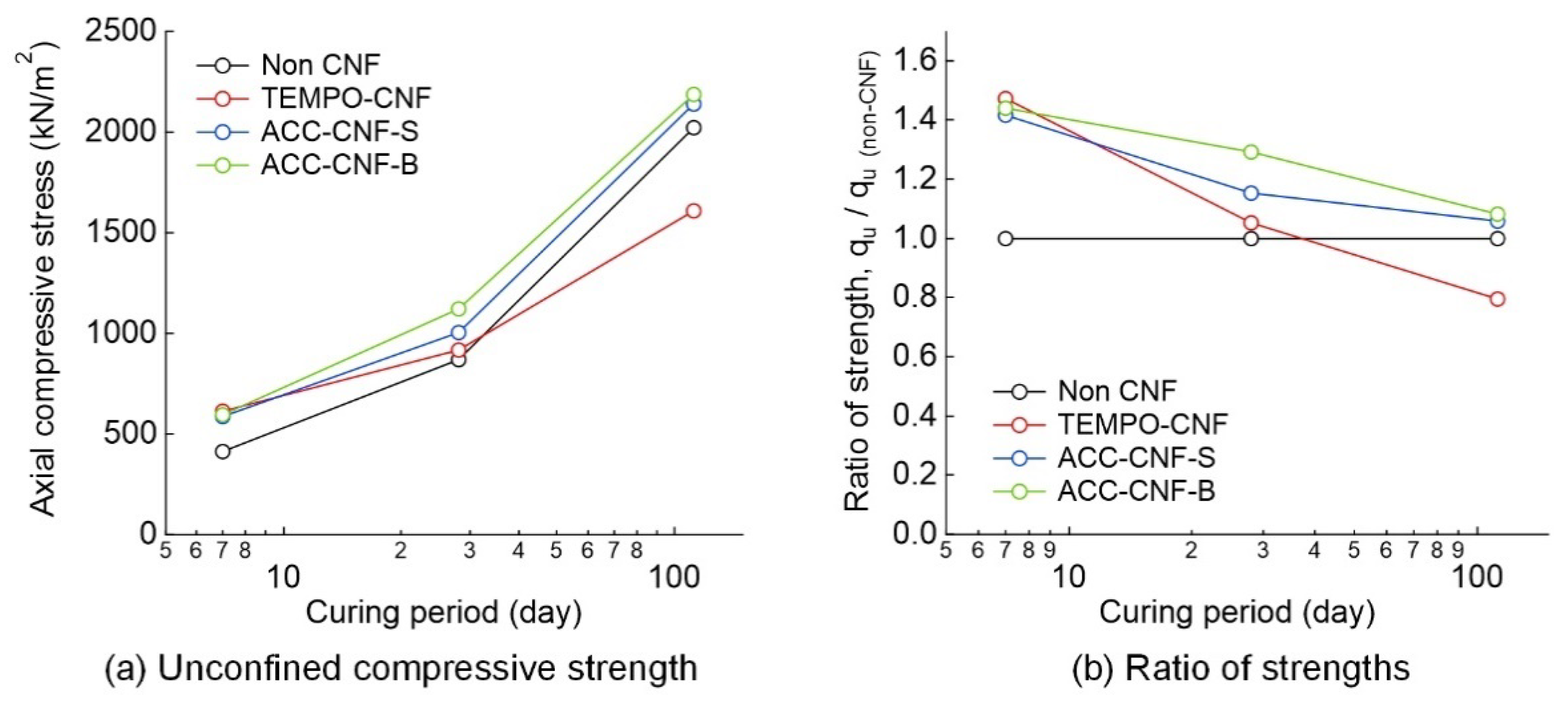

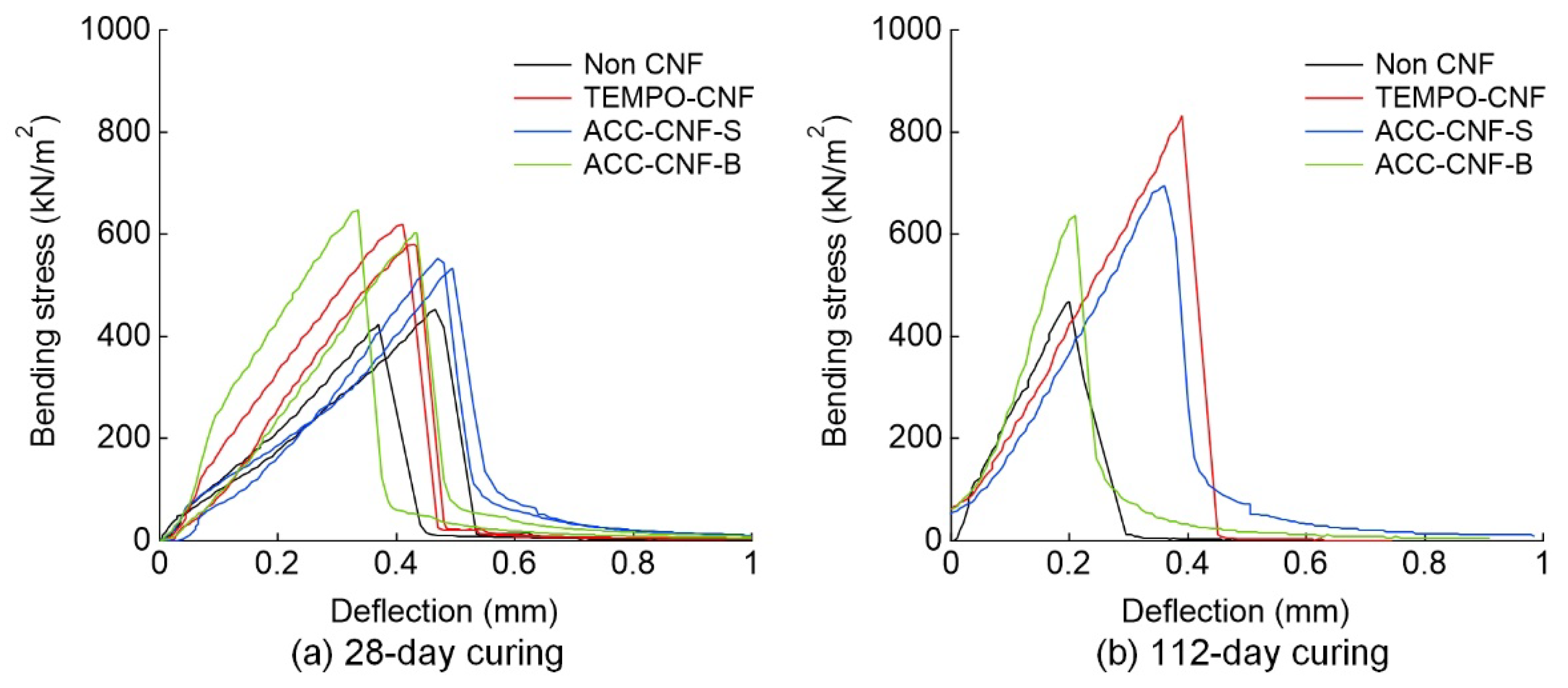
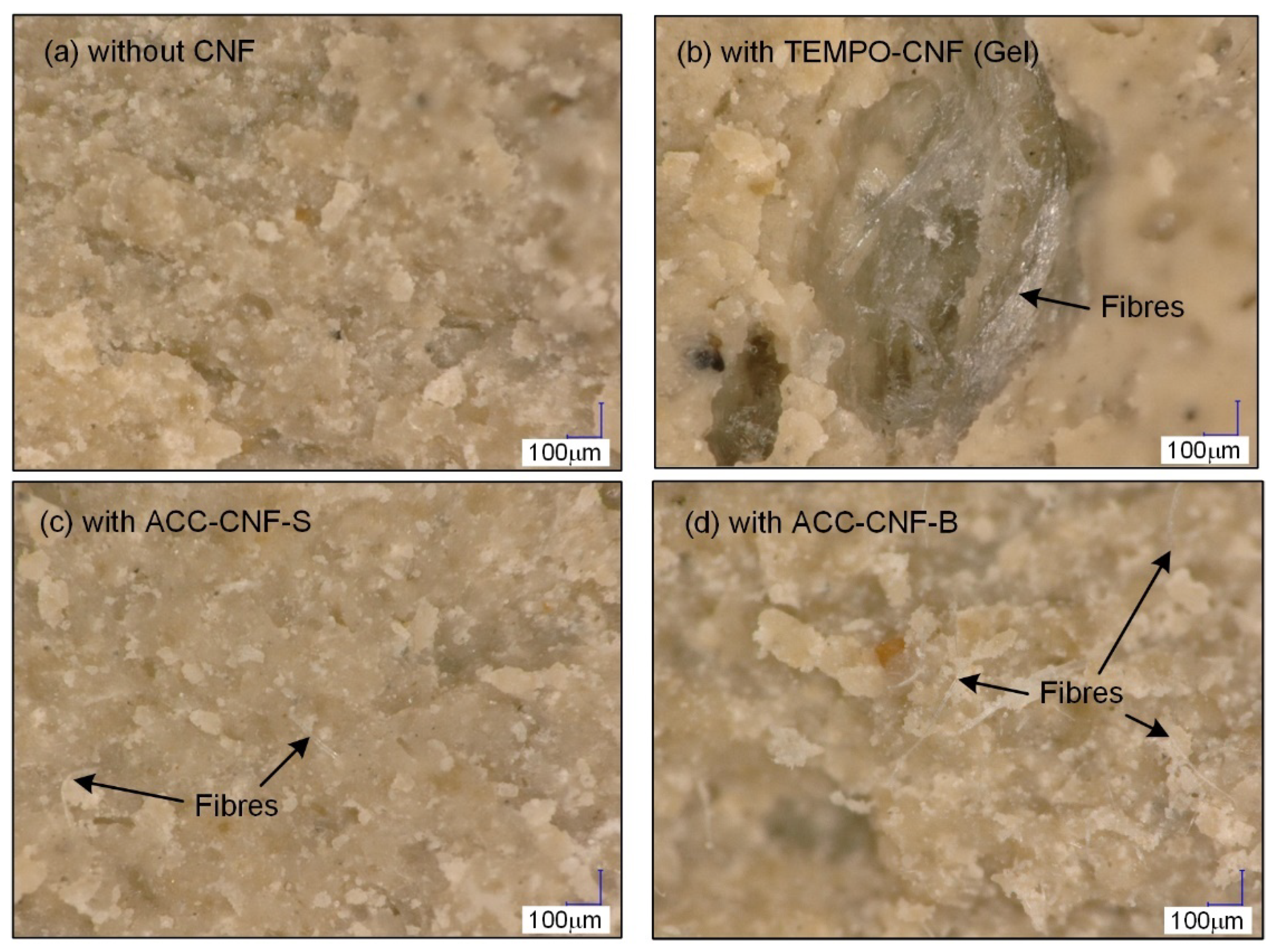
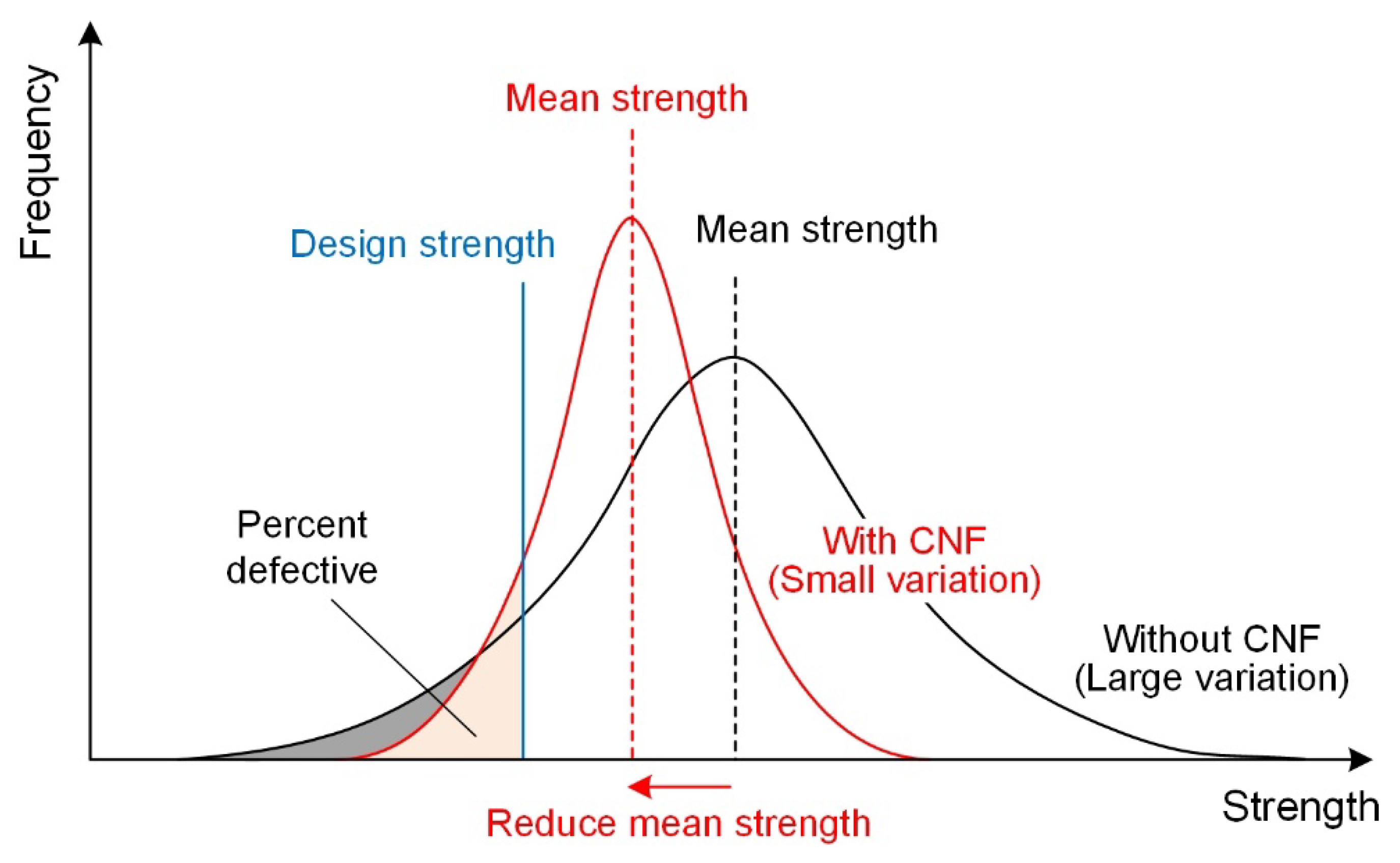
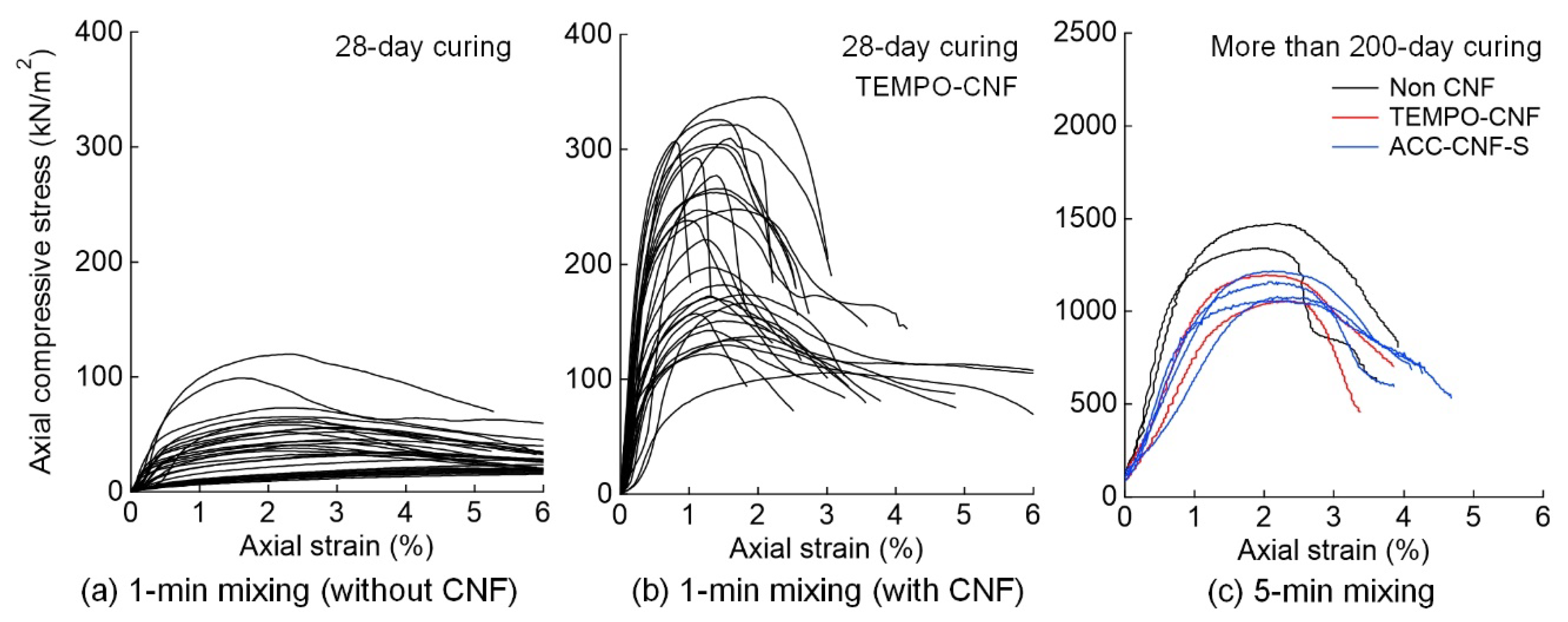

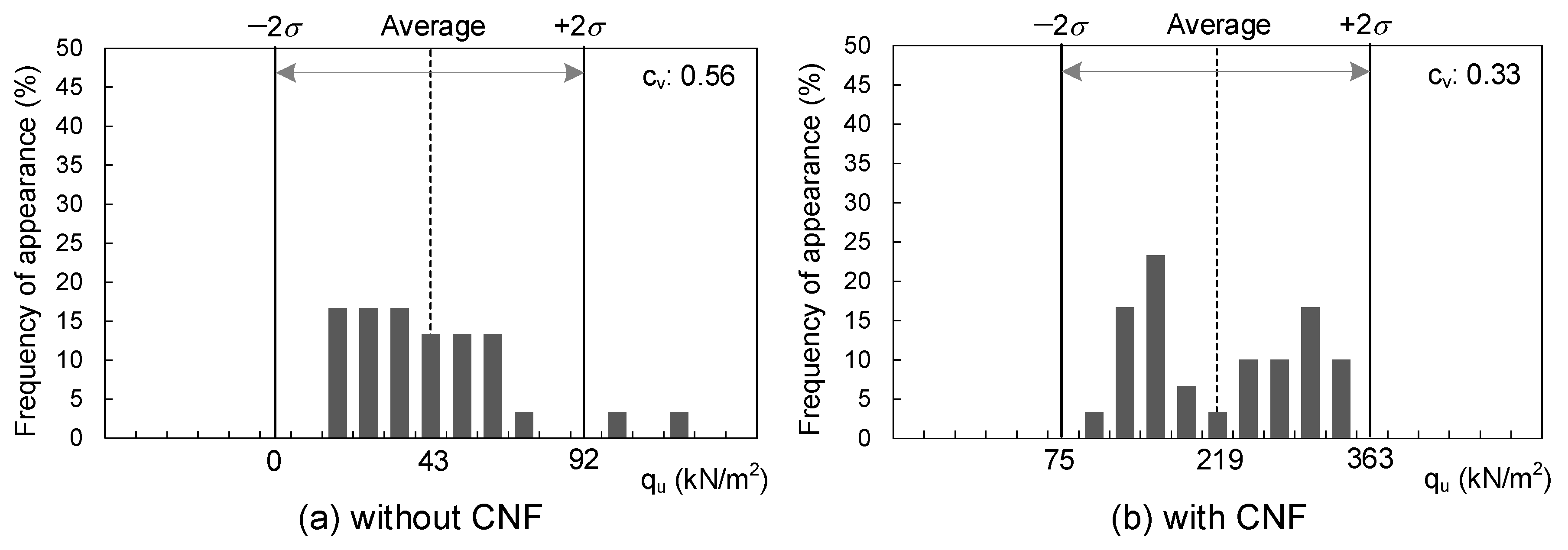
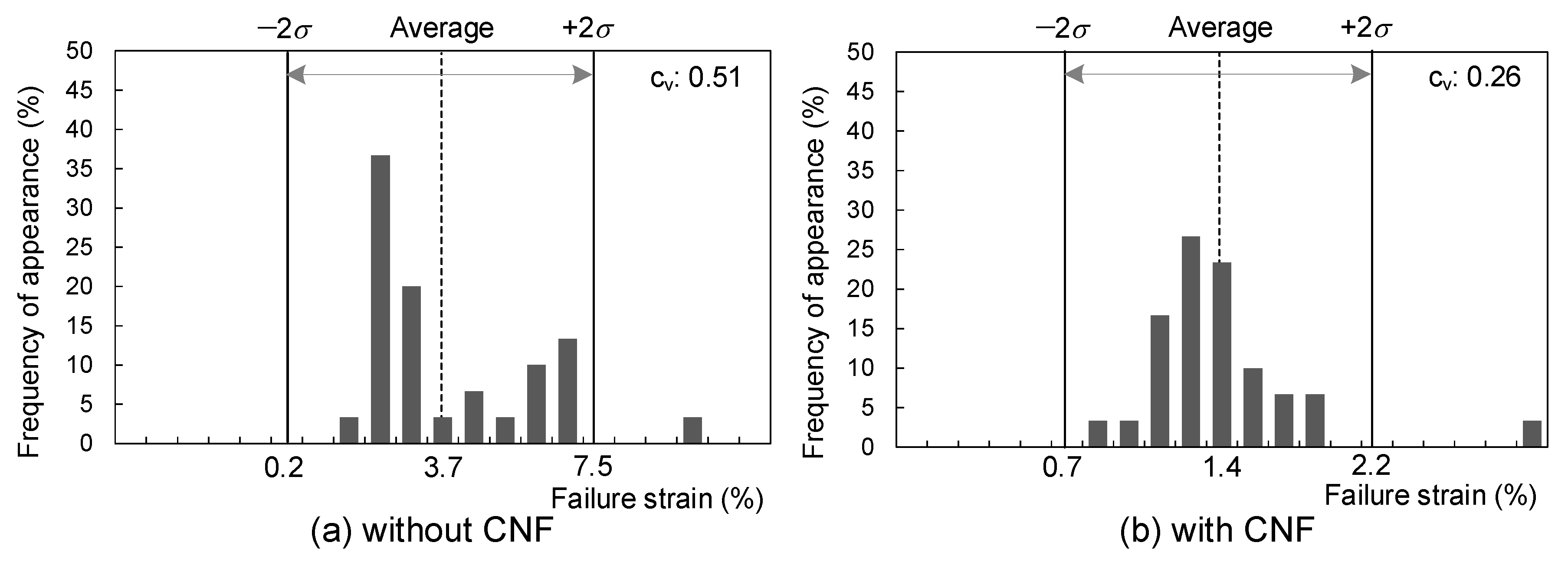
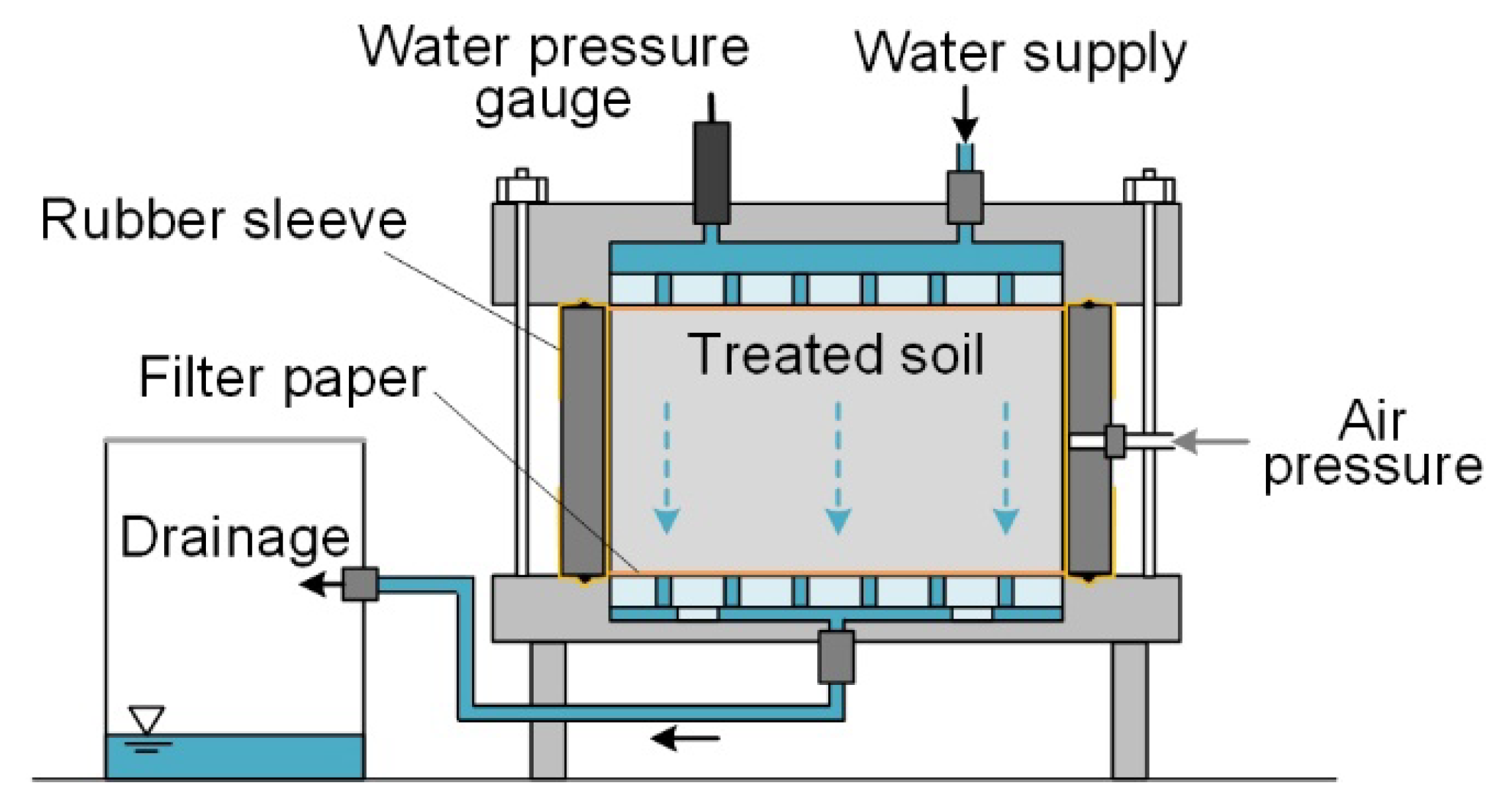


| TEMPO-CNF | ACC-CNF | |||
|---|---|---|---|---|
| Identifier | TEMPO-CNF | TEMPO-CNF | ACC-CNF-S | ACC-CNF-B |
| Raw material | Wood pulp | Wood pulp | Softwood pulp | Bamboo pulp |
| State | Gel | Powder | Gel | Gel |
| Content rate | 2.0% | 90% | 1.8% and 2.0% | 2.0% |
| Defibrating method | Chemical fibrillation | Chemical fibrillation | Physical fibrillation | Physical fibrillation |
| Manufacturing method | TEMPO-mediated oxidation | TEMPO-mediated oxidation | Aqueous counter collision | Aqueous counter collision |
| Appearance |  |  |  |  |
| Kasaoka Clay | Kawasaki Clay | ||
|---|---|---|---|
| Soil particle density, rs (g/cm3) | 2.700 | 2.671 | |
| Initial water content, wi (%) | 6.8 | 61.8 | |
| Grain size | Gravel fraction (2–75 mm) (%) | 0.0 | 0.0 |
| Sand fraction (75 μm–2 mm) (%) | 1.1 | 13.1 | |
| Silt fraction (5–75 μm) (%) | 40.1 | 46.9 | |
| Clay fraction (<5 μm) (%) | 58.8 | 40.0 | |
| Fine fraction content, Fc (%) | 98.9 | 86.9 | |
| Liquid limit, wL (%) | 62.1 | 41.0 | |
| Plastic limit, wP (%) | 20.6 | 23.1 | |
| Plasticity index, IP | 41.5 | 17.9 | |
| (a) | Amounts of Component | CNF Addition Rate (%) | Cement Addition (kg/m3) | ||||||||
| Soil (Kasaoka Clay) | Water | Cement (Ordinary Portland) | CNF –No Addition– | Total | |||||||
| Total | Soil Particle | Water | Total | Solid Content | Water | ||||||
| g | 769 | 725 | 45 | 655 | 100 | 0 | 0 | 0 | 1525 | 0.0 | 100.0 |
| g/cm3 | - | 2.70 | 1.00 | 1.00 | 3.16 | - | 1.5 | 1.0 | 1.52 | ||
| cm3 | 313 | 268 | 45 | 655 | 32 | 0 | 0 | 0 | 1000 | ||
| (b) | Amounts of Component | CNF Addition Rate (%) | Cement Addition (kg/m3) | ||||||||
| Soil (Kasaoka Clay) | Water | Cement (Ordinary Portland) | CNF (TEMPO-CNF) | Total | |||||||
| Total | Soil Particle | Water | Total | Solid Content | Water | ||||||
| g | 769 | 725 | 45 | 300 | 100 | 363 | 7.25 | 355 | 1532 | 1.0 | 99.5 |
| g/cm3 | - | 2.70 | 1.00 | 1.00 | 3.16 | - | 1.5 | 1.0 | 1.52 | ||
| cm3 | 313 | 268 | 45 | 300 | 32 | 360 | 5 | 355 | 1005 | ||
| (c) | Amounts of Component | CNF Addition Rate (%) | Cement Addition (kg/m3) | ||||||||
| Soil (Kasaoka Clay) | Water | Cement (Ordinary Portland) | CNF (ACC-CNF-S) | Total | |||||||
| Total | Soil Particle | Water | Total | Solid Content | Water | ||||||
| g | 769 | 725 | 45 | 260 | 100 | 403 | 7.25 | 396 | 1532 | 1.0 | 99.5 |
| g/cm3 | - | 2.70 | 1.00 | 1.00 | 3.16 | - | 1.5 | 1.0 | 1.52 | ||
| cm3 | 313 | 268 | 45 | 260 | 32 | 400 | 5 | 396 | 1005 | ||
| (d) | Amounts of Component | CNF Addition Rate (%) | Cement Addition (kg/m3) | ||||||||
| Soil (Kasaoka Clay) | Water | Cement (Ordinary Portland) | CNF (ACC-CNF-B) | Total | |||||||
| Total | Soil Particle | Water | Total | Solid Content | Water | ||||||
| g | 769 | 725 | 45 | 300 | 100 | 363 | 7.25 | 355 | 1532 | 1.0 | 99.5 |
| g/cm3 | - | 2.70 | 1.00 | 1.00 | 3.16 | - | 1.5 | 1.0 | 1.52 | ||
| cm3 | 313 | 268 | 45 | 300 | 32 | 360 | 5 | 355 | 1005 | ||
| (a) | Amounts of Component | CNF Addition Rate (%) | Cement Addition (kg/m3) | ||||||||
| Soil (Kawasaki Clay) | Water | Cement (Blast Furnace t. B) | CNF –No Addition– | Total | |||||||
| Total | Soil Particle | Water | Total | Solid Content | Water | ||||||
| g | 1687 | 1030 | 657 | 0 | 50 | 0 | 0 | 0 | 1737 | 0.0 | 47.9 |
| g/cm3 | - | 2.671 | 1.023 | 1.00 | 3.04 | - | 1.5 | 1.0 | 1.662 | ||
| cm3 | 1028 | 386 | 642 | 0 | 16 | 0 | 0 | 0 | 1044 | ||
| (b) | Amounts of Component | CNF Addition Rate (%) | Cement Addition (kg/m3) | ||||||||
| Soil (Kawasaki Clay) | Water | Cement (Blast Furnace t. B) | CNF (TEMPO-CNF) | Total | |||||||
| Total | Soil Particle | Water | Total | Solid Content | Water | ||||||
| g | 1686 | 1030 | 656 | 0 | 50 | 11.43 | 10.30 | 1.13 | 1747 | 1.0 | 47.6 |
| g/cm3 | - | 2.671 | 1.023 | 1.00 | 3.04 | - | 1.5 | 1.0 | 1.662 | ||
| cm3 | 1027 | 386 | 641 | 0 | 16 | 8.00 | 6.87 | 1.13 | 1051 | ||
| (a) | Amounts of Component | CNF Addition Rate (%) | Cement Addition (kg/m3) | ||||||||
| Soil (Kawasaki Clay) | Water | Cement (Early Strength) | CNF –No Addition– | Total | |||||||
| Total | Soil Particle | Water | Total | Solid Content | Water | ||||||
| g | 2000 | 1237 | 763 | 325 | 124 | 0 | 0 | 0 | 2449 | 0.0 | 78.6 |
| g/cm3 | - | 2.671 | 1.023 | 1.00 | 3.14 | - | 1.5 | 1.0 | 1.556 | ||
| cm3 | 1209 | 463 | 746 | 325 | 39 | 0 | 0 | 0 | 1574 | ||
| (b) | Amounts of Component | CNF Addition Rate (%) | Cement Addition (kg/m3) | ||||||||
| Soil (Kawasaki Clay) | Water | Cement (Early Strength) | CNF (TEMPO-CNF) | Total | |||||||
| Total | Soil Particle | Water | Total | Solid Content | Water | ||||||
| g | 2000 | 1237 | 763 | 324 | 124 | 13.74 | 12.37 | 1.37 | 2461 | 1.0 | 78.2 |
| g/cm3 | - | 2.671 | 1.023 | 1.00 | 3.14 | - | 1.5 | 1.0 | 1.556 | ||
| cm3 | 1209 | 463 | 746 | 324 | 39 | 9.62 | 8.25 | 1.37 | 1582 | ||
| (c) | Amounts of Component | CNF Addition Rate (%) | Cement Addition (kg/m3) | ||||||||
| Soil (Kawasaki Clay) | Water | Cement (Early Strength) | CNF (ACC-CNF-S) | Total | |||||||
| Total | Soil Particle | Water | Total | Solid Content | Water | ||||||
| g | 2000 | 1237 | 763 | 0 | 124 | 331.9 | 6.64 | 325.3 | 2456 | 0.5 | 78.4 |
| g/cm3 | - | 2.671 | 1.023 | 1.00 | 3.14 | - | 1.5 | 1.0 | 1.556 | ||
| cm3 | 1209 | 463 | 746 | 0 | 39 | 329.7 | 4.43 | 325.3 | 1578 | ||
Publisher’s Note: MDPI stays neutral with regard to jurisdictional claims in published maps and institutional affiliations. |
© 2021 by the authors. Licensee MDPI, Basel, Switzerland. This article is an open access article distributed under the terms and conditions of the Creative Commons Attribution (CC BY) license (https://creativecommons.org/licenses/by/4.0/).
Share and Cite
Takahashi, H.; Omori, S.; Asada, H.; Fukawa, H.; Gotoh, Y.; Morikawa, Y. Mechanical Properties of Cement-Treated Soil Mixed with Cellulose Nanofibre. Appl. Sci. 2021, 11, 6425. https://doi.org/10.3390/app11146425
Takahashi H, Omori S, Asada H, Fukawa H, Gotoh Y, Morikawa Y. Mechanical Properties of Cement-Treated Soil Mixed with Cellulose Nanofibre. Applied Sciences. 2021; 11(14):6425. https://doi.org/10.3390/app11146425
Chicago/Turabian StyleTakahashi, Hidenori, Shinya Omori, Hideyuki Asada, Hirofumi Fukawa, Yusuke Gotoh, and Yoshiyuki Morikawa. 2021. "Mechanical Properties of Cement-Treated Soil Mixed with Cellulose Nanofibre" Applied Sciences 11, no. 14: 6425. https://doi.org/10.3390/app11146425
APA StyleTakahashi, H., Omori, S., Asada, H., Fukawa, H., Gotoh, Y., & Morikawa, Y. (2021). Mechanical Properties of Cement-Treated Soil Mixed with Cellulose Nanofibre. Applied Sciences, 11(14), 6425. https://doi.org/10.3390/app11146425






